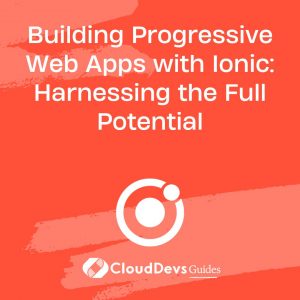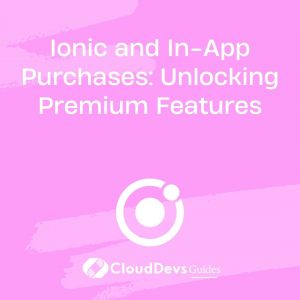Building Progressive Web Apps with Ionic: Harnessing the Full Potential
In the rapidly evolving world of web development, Progressive Web Apps (PWAs) have emerged as a powerful solution to bridge the gap between native mobile apps and traditional websites. PWAs offer users a seamless experience with features like offline access, push notifications, and improved performance. One of the most popular frameworks for building PWAs is Ionic. In this blog, we will explore how to harness the full potential of Progressive Web Apps with Ionic, enabling you to create high-quality, responsive, and engaging applications.
1. What are Progressive Web Apps?
Before we delve into the world of Ionic and its capabilities, let’s have a brief understanding of what Progressive Web Apps are. PWAs are web applications that utilize modern web technologies to provide a native app-like experience to users. They can be accessed through a web browser, eliminating the need for installation from an app store.
PWAs are designed to be responsive, fast, and reliable. They take advantage of service workers to enable offline access and caching, making them accessible even in low or no internet connectivity. Additionally, PWAs can send push notifications, integrate with device features, and offer a user experience similar to that of native mobile apps.
2. Why Choose Ionic for Progressive Web Apps?
Ionic is an open-source UI toolkit that enables developers to build high-quality cross-platform applications using web technologies like HTML, CSS, and JavaScript/TypeScript. It’s built on top of Angular, making it a perfect choice for those already familiar with the Angular framework. Ionic’s core strength lies in its ability to create Progressive Web Apps that look and feel like native applications.
2.1. Full Power of Angular
As mentioned earlier, Ionic is built on top of Angular, a widely used JavaScript framework for web development. By leveraging Angular’s capabilities, Ionic offers developers the full power of a robust framework, allowing for the creation of complex and feature-rich applications.
2.2. UI Components and Theming
Ionic comes with a rich set of UI components and themes that are optimized for both web and mobile platforms. These components help ensure a consistent and polished user interface across different devices and screen sizes.
Code Sample – Ionic Button Component
html <ion-button color="primary"> Click Me </ion-button>
2.3. Cross-Platform Development
One of the significant advantages of Ionic is its ability to deploy applications across multiple platforms with a single codebase. This means you can build an app once and run it on the web, iOS, Android, and other platforms, saving time and development effort.
2.4. Cordova Plugins Integration
While Ionic focuses on building web-based PWAs, it also allows integration with Cordova plugins. This means that if you need access to native device features like camera, GPS, or Bluetooth, you can easily incorporate these functionalities into your Ionic app.
3. Getting Started with Ionic
Now that we understand the potential of Ionic for building PWAs, let’s get started with creating our first Ionic application.
Prerequisites
Before diving in, ensure you have Node.js and npm (Node Package Manager) installed on your system. You can download and install them from the official Node.js website.
Step 1: Installing Ionic CLI
The first step is to install the Ionic Command Line Interface (CLI) globally on your system. The CLI allows you to create, build, and test Ionic projects effortlessly. Open your terminal or command prompt and execute the following command:
bash npm install -g @ionic/cli
Step 2: Creating a New Ionic Project
With the Ionic CLI installed, you can now create a new project. Choose the “blank” starter template for a simple starting point.
bash ionic start my-pwa blank --type=angular cd my-pwa
Step 3: Serving the App
Now, let’s serve the app in your browser using the following command:
bash ionic serve
Congratulations! You’ve successfully set up your first Ionic Progressive Web App. Now, let’s explore some key features of Ionic to enhance your PWA.
4. Enhancing PWAs with Ionic Features
Ionic provides a wide array of features and tools to enhance the capabilities of your Progressive Web Apps. Let’s look at some of the key features that make Ionic a top choice for building PWAs.
4.1. PWA Core Support
Ionic is designed from the ground up to support PWAs, making it easier for developers to incorporate PWA-specific features. With Ionic, you can effortlessly add service workers, enabling your app to work offline and load faster, even in uncertain network conditions.
4.2. Native-like UI/UX
Ionic’s UI components are optimized for mobile devices, providing a native-like experience to users. Additionally, Ionic’s theming capabilities allow you to customize the look and feel of your app to match your brand identity seamlessly.
4.3. Cross-Platform Testing
As your Ionic app is based on web technologies, you can perform cross-platform testing directly in the browser. This accelerates the testing process and allows you to identify and fix issues efficiently.
Code Sample – Responsive Ionic Grid
html
<ion-grid>
<ion-row>
<ion-col size="6">Column 1</ion-col>
<ion-col size="6">Column 2</ion-col>
</ion-row>
</ion-grid>
4.4. Push Notifications
Ionic integrates easily with push notification services, enabling you to send real-time updates to users and keep them engaged. This feature is especially crucial for user retention and re-engagement.
Conclusion
Progressive Web Apps have revolutionized the way users interact with web applications, offering a seamless experience that’s akin to native mobile apps. Ionic, with its powerful features and robust capabilities, is the perfect framework for building high-quality PWAs.
In this blog, we explored the essence of Progressive Web Apps and why Ionic stands out as an excellent choice for creating them. We also walked through the initial setup of an Ionic app and highlighted some of the key features that make it the go-to solution for PWA development.
Now it’s time for you to dive deeper into the world of Ionic and PWAs. Explore the vast potential, experiment with various features, and unlock the full power of Progressive Web Apps with Ionic. Happy coding!
Remember, the journey of web development is ever-evolving, and staying up-to-date with the latest trends and technologies is crucial. Embrace the learning process, and you’ll be amazed at what you can achieve with Ionic and Progressive Web Apps.
Table of Contents








